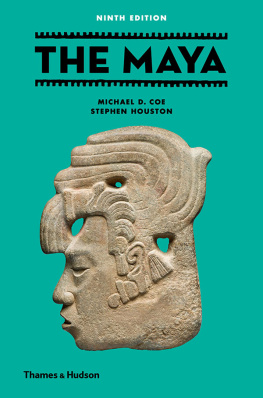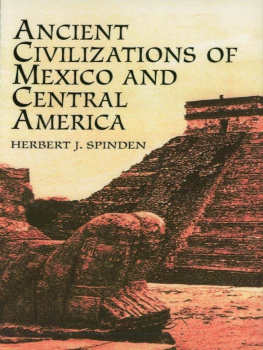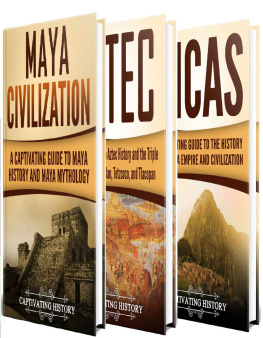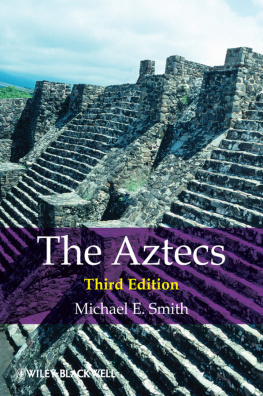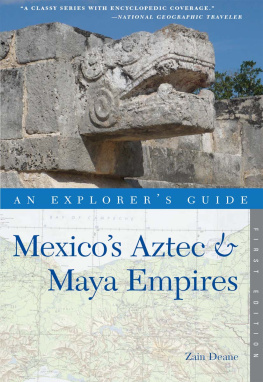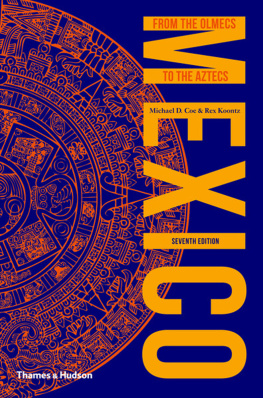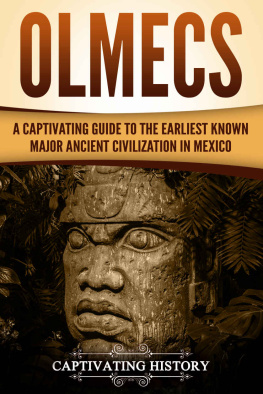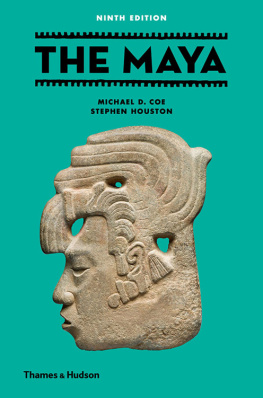Michael D. Coe - Mexico: From the Olmecs to the Aztecs
Here you can read online Michael D. Coe - Mexico: From the Olmecs to the Aztecs full text of the book (entire story) in english for free. Download pdf and epub, get meaning, cover and reviews about this ebook. year: 0, genre: Art. Description of the work, (preface) as well as reviews are available. Best literature library LitArk.com created for fans of good reading and offers a wide selection of genres:
Romance novel
Science fiction
Adventure
Detective
Science
History
Home and family
Prose
Art
Politics
Computer
Non-fiction
Religion
Business
Children
Humor
Choose a favorite category and find really read worthwhile books. Enjoy immersion in the world of imagination, feel the emotions of the characters or learn something new for yourself, make an fascinating discovery.

- Book:Mexico: From the Olmecs to the Aztecs
- Author:
- Genre:
- Year:0
- Rating:3 / 5
- Favourites:Add to favourites
- Your mark:
- 60
- 1
- 2
- 3
- 4
- 5
Mexico: From the Olmecs to the Aztecs: summary, description and annotation
We offer to read an annotation, description, summary or preface (depends on what the author of the book "Mexico: From the Olmecs to the Aztecs" wrote himself). If you haven't found the necessary information about the book — write in the comments, we will try to find it.
Mexico: From the Olmecs to the Aztecs — read online for free the complete book (whole text) full work
Below is the text of the book, divided by pages. System saving the place of the last page read, allows you to conveniently read the book "Mexico: From the Olmecs to the Aztecs" online for free, without having to search again every time where you left off. Put a bookmark, and you can go to the page where you finished reading at any time.
Font size:
Interval:
Bookmark:

About the Authors
Michael D. Coe is Professor Emeritus of Anthropology at Yale University. Among his many publications is the companion volume to this book, The Maya, now revised in its eighth edition.
Rex Koontz is Director of the School of Art and Professor of Art History at the University of Houston and has written widely on ancient Mexican art, architecture and aesthetics.
Other titles by Michael D. Coe published by
Thames & Hudson include:
Breaking the Maya Code
Final Report: An Archaeologist Excavates His Past
The Maya
Royal Cities of the Ancient Maya
The True History of Chocolate (with Sophie D. Coe)
Other titles of interest published by
Thames & Hudson include:
Ancient Mexico and Central America: Archaeology and Culture History by Susan Toby Evans
The Aztecs by Richard F. Townsend
Chronicle of the Maya Kings and Queens: Deciphering the Dynasties of the Ancient Maya by Simon Martin and Nikolai Grube
The Olmecs: Americas First Civilization by Richard A. Diehl
Palenque: Eternal City of the Maya by David Stuart and George Stuart
Reading Maya Art: A Hieroglyphic Guide to Ancient Maya Painting and Sculpture by Andrea Stone and Marc Zender
See our websites
www.thamesandhudson.com
www.thamesandhudsonusa.com

Ancient Peoples and Places
FOUNDING EDITOR: GLYN DANIEL

Contents

The subject matter of this book is the story of the pre-Spanish peoples of Mexico, who with their neighbors the Maya were the most advanced of the American Indians north of the Andes. The term Mexico will here refer to all the land in that Republic which lies between the western border of the Maya civilization and the northern frontier where Mexican farmers once met the nomadic tribesmen of the desert. This is roughly the area covered by the old Viceroyalty of New Spain in early Colonial times.
We have found it both feasible and justifiable to exclude the ancient Maya from this survey, although part of their territory was, in fact, within the boundaries of the present-day Estados Unidos de Mxico. The Maya civilization of the Yucatan Peninsula and Central America was so extraordinarily complex that to do it justice would be impossible within the confines of the present volume. With a few notable exceptions, those remarkable people would appear to have remained within their own borders throughout the centuries; accordingly, other native cultures of the Republic can be considered quite independently. The latest revised edition of The Maya, the companion volume in the series, should be read with this book; we have made every effort to give each volume the same format and general approach.
We have once again incorporated in this new edition of Mexico many of the most recent findings, from a number of disciplines. The long-standing puzzle of the origin of maize farming has at last been solved. Several spectacular new discoveries throw more light on the Olmec culture, Mexicos earliest civilization. At the great city of Teotihuacan, recent investigations in the earliest monumental pyramid indicate the antiquity of certain sacrificial practices and the symbolism of the pyramid. The Huastec region of the northeastern Gulf of Mexico is covered in greater detail than in previous editions. And further discoveries in the sacred precinct of the Aztec capital Tenochtitlan have allowed us to refine our understanding of the history and symbolism of this hallowed area.
Some may be disappointed to find the Aztec empire confined to a chapter and a half. Aztec and Mexico seem almost synonymous, but we now know that in the total span of human occupation of that country, the Aztecs were late arrivals, their empire but a final and brilliant flicker before the light of native civilization was put out once and for all. Nevertheless, thanks to the accounts of Spanish friars and conquistadores, and to native and creole (Mexican-born) historians, we have more information on this civilization than on any other native culture of the New World. Each generation of scholars brings new insights and understandings to the study of the Aztecs, and we have tried to incorporate some of the latest into this volume.
It is all too easy to treat the pre-Spanish cultures of Mexico and Central America as dead, yet in spite of the cataclysm of the Conquest and the ensuing epidemics which decimated the native peoples, the indigenous populations have survived through the Colonial period and into the present; in fact, much of the flavor of modern Mexico derives, both consciously and unconsciously, from its ancient heritage. Accordingly, we have included an Epilogue which takes these peoples through the Conquest up to our own day.
A matter which must be touched upon is the pronunciation of the very formidable-looking words and names of ancient Mexico. Most of these are in Nahuatl, the national tongue of the Aztec state, and were transcribed in Roman letters by the early Spanish friars in terms of the language spoken in central Spain in the sixteenth century. Thus, vowels and most consonants are generally pronounced as they would be in Spanish, with these exceptions:
x has the sound of the English sh, as it once had in Spanish (witness the derivation of sherry from the Spanish Xerez).
tl this cluster is a voiceless surd consonant, much like the Welsh ll.
hu followed by a vowel is pronounced like English w.
In Nahuatl, word stress always fall on the penultimate (next-to-last) syllable. We have therefore omitted all accents in such words and names. However, various corruptions have crept into Nahuatl from Spanish, including occasional stress placed on the final syllable (e.g. in many books, Teotihuacn is found in place of the more correct Teotihucan).
We have used the correct Nahuatl form Motecuhzoma (Angry Like a Lord) for the third and seventh Aztec kings, although Moteuhczoma is also permissible. The familiar Montezuma is hopelessly wrong and merely reflects the inability of most Spaniards to pronounce native names.
In recent decades, there have been important advances in the accurate correlation of dates derived from radiocarbon determinations with those of the Christian calendar (or sidereal years). Dendrochronological studies of the bristlecone pine now affirm that prior to the Christian era, radiocarbon dates are significantly younger than true years. For example, according to radiocarbon determinations, the Olmec civilization at San Lorenzo begins around 1200 BC, but the new calibration curve would more accurately place this some 300 years earlier. In this edition, all ages based upon the radiocarbon method have been so calibrated, as they have in The Maya.
Many scholars have aided us in the preparation of this and earlier editions, if only through their published work. For the present edition, we would especially like to thank Dr Javier Urcid, who made many useful suggestions to bring Mexico up to date on the latest discoveries and interpretations, and Dr Randolph Widmer for a close reading of the section on Teotihuacan. And we thank the staff of Thames & Hudson for their help in enabling us to present often complex archaeological research to the general reader.
Next pageFont size:
Interval:
Bookmark:
Similar books «Mexico: From the Olmecs to the Aztecs»
Look at similar books to Mexico: From the Olmecs to the Aztecs. We have selected literature similar in name and meaning in the hope of providing readers with more options to find new, interesting, not yet read works.
Discussion, reviews of the book Mexico: From the Olmecs to the Aztecs and just readers' own opinions. Leave your comments, write what you think about the work, its meaning or the main characters. Specify what exactly you liked and what you didn't like, and why you think so.


